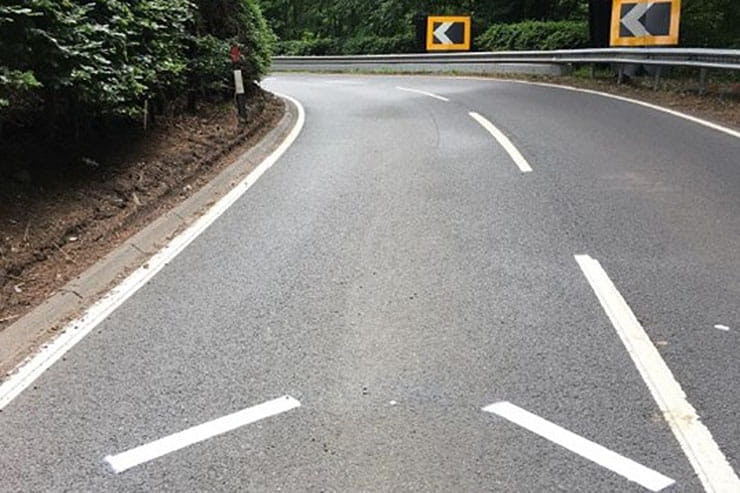Road markings promote safer cornering
By Ben Purvis
Motorcycle Journalist
18.12.2023
A Scottish motorcycle safety project that uses ‘nudge psychology’ to influence rider behaviour rather than punitive measures has proved a roaring success and won a Prince Michael International Road Safety Award after initial trials.
Project PRIME – which (sort of) stands for Perceptual Rider Information for Maximising Expertise and Enjoyment – has been implemented at 22 trial sites in the West of Scotland for three years, during which time video footage of 32,213 riders has been manually checked and shows that bikes in the trial areas reduce speed, improve their road position both on the approach to corners and mid-bend, and show better braking behaviour. And it’s not some sort of training scheme or expensive, heavy-handed enforcement project but a simple set of road signs and markings.
Since the start of the trial, the results have been impressive, with zero motorcycle injury collisions at the selected trial sites.
The PRIME approach, developed by Transport Scotland along with the Road Safety Trust, BEAR Scotland and led by Professor Alex Stedmon of the University of Nottingham – himself a rider – uses chevron-shaped road markings and signs ahead of corners to ‘nudge’ riders toward the centre of their lane, encouraging a safer line through the corner where they’re less likely to encroach on the lane of oncoming traffic.
Its success is such that it won both Road Safety Scheme of the Year and the Judges’ Special Merit Award at the UK Transport Awards.
The system itself is simple, involving what Stedmon describes as “three truncated chevron markings with a gap in the middle so it forms a gateway for motorcyclists to ride through” but came about after a substantial amount of research. These chevrons not only encourage riders to position their bikes better for the oncoming corner, but at several sites they also resulted in riders braking earlier and reduced the amount of mid-corner braking that was happening.
Stedmon said: “It is an incredible honour to receive this award for Project PRIME, especially with its focus on motorcyclists who are one of the most vulnerable types of road user.
“This work has provided a unique opportunity to use fundamental principles of Applied Psychology in real-world trials with many tens of thousands of riders. The work also underpins Scotland’s Road Safety Framework to 2030 and the wider Safe System approach to road safety.
“Throughout Project PRIME we have involved motorcyclists in the development of this casualty reduction initiative, so that the road markings are something they will accept and use. It has been developed for motorcyclists by motorcyclists.
“As a psychologist and also a keen motorcyclist, I am very proud to have led the research on this work. While solution might appear simple, the science behind it is complex. However, it would not have been possible without the support and commitment of the Road Safety Trust, Transport Scotland, BEAR Scotland and Open Road Simulation.
“Receiving the Prince Michael International Road Safety Award will elevate the importance of this work and the significant social and economic impact of Project PRIME around the world."
Scottish Minister for Transport, Fiona Hyslop, has described the evidence of Project PRIME’s impact on casualties as ‘astounding’ and ‘a tremendous achievement’ and given the trial’s success it’s likely that the same approach will be adopted elsewhere in the country. Hyslop also said that it’s “an approach that could be used globally under similar road conditions.”
PRIME is a lower-cost option than alternatives like reengineering road layouts, implementing more complex traffic-calming measures or adding technology-based systems like speed cameras. On the announcement of the trial results, Ian Stewart, representative of BEAR Scotland, the country’s leading road maintenance and management firm, said: “This work has the potential to be a low cost, highly beneficial road safety improvement scheme that will help reduce motorcycle accidents on our roads for years to come. It is anticipated that the trials will be expanded further in the next few years and potentially be rolled out across the wider trunk road network and local road network in Scotland.”
Transport Scotland’s Summary Report on the three-year trial said: “As far as the research consortium are aware, this is the most in-depth investigation of motorcycle rider behaviour to date. With 32,213 motorcycles manually counted, coded and analysed, the results provide substantial evidence that PRIME road markings had strong, sustained, and long-term effects on speed, position and braking. There was no evidence that PRIMEs had a detrimental effect on rider behaviour. In addition, while the collision data are low and not always known for each site, since the start of the trials there have been no motorcycle injury collisions at any of the previously identified cluster sites.”
If you’d like to chat about this article or anything else biking related, join us and thousands of other riders at the Bennetts BikeSocial Facebook page.
Project PRIME
New road markings trialled across the west of Scotland have demonstrated their success in improving the riding behaviour of motorcyclists taking left hand bends.
The markings, called Perceptual Rider Information for Maximising Expertise and Enjoyment (PRIMEs), are designed to help riders make better decisions.
Share on social media:

